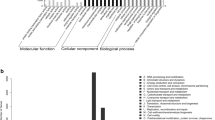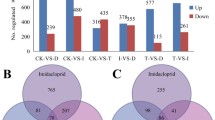Abstract
To understand the molecular mechanism of Pardosa laura in response to beta-cypermethrin (beta-CP) stress, next generation RNA-seq technique was employed to analyse the expression patterns of resistance- and stress-response genes in P. laura subjected to beta-CP. De novo sequence assembly yielded 49,003 unigenes, 20,912 of which were annotated in the public databases. A total of 370 up or down-regulated genes altered by beta-CP were detected, among them, 318 unigenes were upregulated, including one GST, one GPx, five CYP450s, two HSPs (one HSP70 and one HSP20) and two ABC transporters. Functional enrichment analysis revealed that carbon metabolism, glutathione metabolism, drug metabolism-CYP450, oxidative phosphorylation, as well as lysosome, phagosome and mTOR signaling pathway were predominately enriched in response to beta-CP stress. Certain critical genes involved in detoxification were detected to be differentially expressed between the beta-CP treated and control spiders. These results provide a fundamental resource for further research in the molecular characterisation of P. laura responding to pesticide.




Similar content being viewed by others
Data accessibility
Transcriptome sequencing raw data are available in the NCBI Short Archive (SRA) database with accession number PRJNA735032, including the transcriptome TC1 (SRR14728264), TC2 (SRR14728263), TC3 (SRR14728262), T-CBP1 (SRR14728261), T-CBP2 (SRR14728260) and T-CBP3 (SRR14728259).
References
Baatrup E, Bayley M (1993) Effects of the pyrethroid insecticide cypermethrin on the locomotor activity of the wolf spider Pardosa amentata: quantitative analysis employing computer-automated video tracking. Ecotox Environ Safe 26:138–152
Balakrishnan B, Su S, Wang K, Tian R, Chen M (2018) Identification, expression, and regulation of an omega class glutathione S-transferase in Rhopalosiphum padi (L.) (Hemiptera: Aphididae) under insecticide stress. Front Physiol 9:427
Benjamini Y, Hochberg Y (1995) Controlling the false discovery rate: A practical and powerful approach to multiple testing. J R Stat Soc Ser B Stat Methodol 57:289–300
Cao GC, Jia M, Zhao X, Wang L, Tu XB, Wang GJ, Nong XQ, Zhang ZH (2017) Effects of chlorantraniliprole on detoxification enzymes activities in Locusta migratoria L. J Asia-Pac Entomol 20:741–746
Casida JE, Durkin KA (2013) Neuroactive insecticides: targets, selectivity, resistance, and secondary effects. Annu Rev Entomol 58:99–117
Che-Mendoza A, Penilla RP, Rodrìguez DA (2009) Insecticide resistance and glutathione S-transferases in mosquitoes: A review. Afr J Biotechnol 8:1386–1397
Chen XQ, Xiao Y, Wu LB, Chen YF, Peng Y (2012) Imidacloprid affects Pardosa Pseudoannulata adults and their unexposed offspring. Bull Environ Contam Toxicol 88:654–658
Marco L, De Sassera1 D, Epis S, Mastrantonio V, Ferrari M, Ricci I, Comandatore F, Bandi C, Porretta D, Urbanelli C (2017) The choreography of the chemical defensome response to insecticide stress: insights into the Anopheles stephensi transcriptome using RNA-Seq. Sci Rep 7:41312
Deng LL, Dai JY, Cao H, Xu MQ (2006) Effects of an organophosphorous insecticide on survival, fecundity, and development of Hylyphantes graminicola (Sundevall) (Araneae: Linyphiidae). Environ Toxicol Chem 25:3073–3077
Diel F, Horr B, Borck H, Irman-Florjanc T (2003) Pyrethroid insecticides influence the signal transduction in T helper lymphocytes from atopic and nonatopic subjects. Inflamm Res 52:154–163
Ehler LE (2006) Integrated pest management (IPM): definition, historical development and implementation, and the other IPM. Pest Manag Sci 62:787–789
El-WakeilN, Gaafar N, Sallam A, Volkmar C (2013) Side effects of insecticides on natural enemies and possibility of their integration in plant protection strategies. In: Trdan Insecticides: development of safer and more effective technologies. 1–56
Enayati AA, Ranson H, Hemingway J (2005) Insect glutathione transferases and insecticide resistance. Insect Mol Biol 14:3–8
Epis S, Porretta D, Mastrantonio V, Comandatore F, Sassera D, Rossi P, Cafarchia C, Otranto D, Favia G, Genchi C, Bandi C, Urbanelli S (2014) ABC transporters are involved in defense against permethrin insecticide in the malatria vector Anopheles stephensi. Parasite Vector 7:349
Gong YH, Li T, Zhang L, Gao XW, Liu NN (2013a) Permethrin induction of multiple cytochrome P450 genes in insecticide resistant mosquitoes, Culex quinquefasciatus. Int J Biol Sci 9:863–871
Gong YJ, Wang ZH, Shi BC, Kang ZJ, Zhu L, Jin GH, Wei SJ (2013b) Correlation between pesticide resistance and enzyme activity in the diamondback moth. Plutella Xylostella J Insect Sci 13:135
Grabherr MG, Haas BJ, Yassour M, Levin JZ, Thompson DA, Amit I, Adiconis X, Fan L, Raychowdhury R, Zeng Q, Chen Z, Mauceli E, Hacohen N, Gnirke A, Rhind N, diPalma F, Birren BW, Nusbaum C, Lindblad-Toh K, Friedman N, Regev A (2011) Full-length transcriptome assembly from RNA-Seq data without a reference genome. Nat Biotechnol 29:644–652
Guo Y, Wu H, Zhang X, Ma E, Guo Y, Zhu KY, Zhang J (2016) RNA interference of cytochrome P450 CYP6F subfamily genes affects susceptibility to different insecticides in Locusta migratoria. Pest Manag Sci 72:2154–2165
He C, Liang JJ, Liu SN, Wang SL, Wu QJ, Xie W, Zhang YJ (2019) Changes in the expression of four ABC transporter genes in response to imidacloprid in Bemisia tabaci Q (Hemiptera: Aleyrodidae). Pestici Biochem Phys 153:136–143
Oakley A (2011) Glutathione transferases: a structural perspective. Drug Metab Rev 43:183–151
Kim RO, Rhee JS, Won EJ, Lee KW, Kang CM, Lee YM, Lee JS (2011) Ultraviolet B retards growth, induces oxidative stress, and modulates DNA repair-related gene and heat shock protein gene expression in the monogonont rotife, Brachionus sp. Aquat Toxicol 101:529–539
Moniruzzaman M, Das D, Dhara A, Chakraborty SB (2020) Enzymatic, non-enzymatatic antioxidant levels and heat shock protein expression as indicators of metal induced toxicity and reproductive modulation in female indian major carp Cirrhinus cirrhosus. Bull Environ Contam Toxicol 104:235–244
Košulič O, Vichitbandha P, Pung T, Michalko R (2018) Lethal and sublethal effects of Embelia ribes and two commercial pesticides on a generalist predator. J Appl Entomol 142:428–436
Li CC, Wang Y, Li GY, Yun YL, Dai YJ, Chen J, Peng Y (2016) Transcriptome profiling analysis of wolf spider Pardosa pseudoannulata (Araneae: Lycosidae) after cadmium exposure. Int J Mol Sci 17:2033
Li CC, GY, Yun YL, Chen J, Zhang ZT, Peng Y, (2016) The effect of cadmium exposure on fitness-related traits and antioxidant responses in the wolf spider, Pardosa pseudoannulata. Bull Environ Contam Toxicol 97:31–36
Li F, Ma H, Liu J (2018) Pyrethroid insecticide cypermethrin modulates gonadotropin synthesis via calcium homeostasis and ERK1/2 Signaling in LβT2 mouse pituitary cells. Toxicol Sci 162:43–52
Lin T, Liu QS, Chen JX (2016) Identification of differentially expressed genes in Monochamus alternatus digested with azadirachtin. Sci Rep 6:33484
Liu NN, Li M, Gong YH, Liu F, Li T (2015) Cytochrome P450s – their expression, regulation, and role in insecticide resistance. Pestic Biochem Physiol 120:77–81
Liu W, Tian JH, Hou NN, Yu N, Zhang YX, Liu ZW (2019) Identifification, genomic organization and expression pattern of glutathione transferase in Pardosa pseudoannulata. Comp Biochem Phys D 32:100626
Livak KJ, Schmittgen TD (2001) Analysis of relative gene expression data using real-time quantitative PCR and the 2-△△CT method. Method 25:402–408
Li X, Berenbaum SMA, MR, (2007) Molecular mechanisms of metabolic resistance to synthetic and natural xenobiotics. Annu Rev Entomol 52:231–253
Li YC, Chen FY (1986) Observation on the life history of Pardosa laura. Chinese J Zool 7–10 (in Chinese)
Lu H, Zhong YH, Liu K, Du Q (2010) The toxicity determination of 6 Insecticides against the banana flower thrips Thrips hamaiiensis (Morgan). Chin Agr Sci Bull 26:240–242
Lu K, Chen X, Liu WT, Zhang ZC, Wang Y, You KK, Li Y, Zhang RB, Zhou Q (2017) Characterization of heat shock protein 70 transcript from Nilaparvata lugens (Stål): its response to temperature and insecticide stresses. Pestic Biochem Phys 142:102–110
Naranjo SE (2001) Conservation and evaluation of natural enemies in IPM systems for Bemisia tabaci. Crop Prot 20:835–852
Pasquet A, Tupinier N, Mazzia C, Capowiez Y (2016) Exposure to spinosad affects orb-web spider (Agalenatea redii) survival, web construction and prey capture under laboratory conditions. J Pest Sci 89:507–515
Pavlidi N, Vontas J, Leeuwen TV (2018) The role of glutathione S-transferases (GSTs) in insecticide resistance in crop pests and disease vectors. Curr Opin Insect Sci 27:97–102
Pekár S (2012) Spiders (Araneae) in the pesticide world: an ecotoxicological review. Pest Manag Sci 68:1438–1446
Pertea G, Huang X, Liang F, Antonescu V, Sultana R, Karamycheva S, Lee Y, White J, Cheung F, Parvizi B, Tsai J, Quackenbush J (2003) TIGR gene indices clustering tools (TGICL): a software system for fast clustering of large EST datasets. Bioinformatics 19:651–652
Petcharad B, Košulič O, Michalko R (2018) Insecticides alter prey choice of potential biocontrol agent Philodromus cespitum (Araneae, Philodromidae). Chemosphere 202:491–497
Pickett CB, Lu AYH (1989) Glutathione-S-transferases: gene structure, regulation and biological function. Annu Rev Biochem 58:743–764
Robertson JL, Preisler HK (1992) Pesticide bioassays with arthropods. CRC, Boca Raton, Florida
Samu F, Szinetár C (2002) On the nature of agrobiont spiders. J Arachnol 30:389–402
Shilova VY, Zatsepina OG, Garbuz DG, Funikov SY, Zelentsova ES, Schostak NG, Kulikov AM, Evgen’ev MB (2017) Heat shock protein 70 from a thermotolerant Diptera species provides higher thermoresistance to Drosophila larvae than correspondent endogenous gene. Insect Mol Biol 27:61–72
Sillapawattana P, Schäffer A (2017) Effects of imidacloprid on detoxifying enzyme glutathione S-transferase on Folsomia candida (Collembola). Environ Sci Pollut Res 24:11111–11119
Soderlund DM (2012) Molecular mechanisms of pyrethroid insecticide neurotoxicity: recent advances. Arch Toxicol 86:165–181
Song YZ, Chen MD, Zhou JY (2017) Effects of three pesticides on superoxide dismutase and glutathione-S-transferase activities and reproduction of Daphnia magna. Arch Environ Prot 43:80–86
Thompson BJ, Giancotti FG (2018) Editorial overview: Cell signalling: Signal transduction to the nucleus, cytoskeleton, and organelles. Curr Opin Cell Biol 51:4–7
Wang L, Feng Z, Wang X, Wang X, Zhang X (2010) DEGseq: an R package for identifying differentially expressed genes from RNAseq data. Bioinformatics 26:136–138
Wang RL, Zhu-Salzman K, Baerson SR, Xin XW, Li J, Su YJ, Zeng RS (2017) Identification of a novel cytochrome P450 CYP321B1 gene from tobacco cutworm (Spodoptera litura) and RNA interference to evaluate its role in commonly used insecticides. Insect Sci 24:235–247
Wang Y, Xiong L, Tang HF, Sheng XM, Lou A, Li J (2006) Effectiveness of beta-cypermethrin on glutamic-pyruvic transaminase (GPT) and glutamic-oxaloacetic transaminase (GOT) activities from crucian carp (Carassius auratus) serum. Acta Hydro Boil Sinica 30:680–683
Xiao D, Tan XL, Wang WJ, Zhang F, Desneux N, Wang S (2017) Modification of flight and locomotion performances, respiratory metabolism, and transcriptome expression in the lady beetle Harmonia axyridis through sublethal pesticide exposure. Front Physiol 8:33
Xiao D, Zhao J, Guo X, Li S, Zhang F, Wang S (2016) Sublethal effect of beta-cypermethrin on development and fertility of the Asian multicoloured ladybird beetle Harmonia axyridis. J Appl Entomol 140:598–608
Yang HL, Peng YD, Tian JX, Wang J, Hu JL, Song QS, Wang Z (2017) Review: biosafety assessment of Bt rice and other Bt crops using spiders as example for non-target arthropods in China. Plant Cell Rep 36:505–517
Yang HL, Peng YD, Tian JX, Wang J, Wei BY, Xie CL, Wang Z (2018) Rice field spiders in China: a review of the literature. J Econ Entomol 111:53–64
Zhou L, Fang SM, Huang K, Yu QY, Zhang Z (2015) Characterization of an epsilon-class glutathione S-transferase involved in tolerance in the silkworm larvae after long term exposure to insecticides. Ecotox Environ Safe 120:20–26
Zhao JZ (1993) Spiders in the cotton fields in China. Wuhan press, Wuhan (in Chinese)
Funding
This study was supported by Science and Technology Innovation Program of Hubei Province (2018ABA098), Central-guided Local Project of Sci & Tech Development (2019ZYYD045), Natural Science Fund of Hubei Province (2017CFB609).
Author information
Authors and Affiliations
Contributions
Chang-chun Li conceived and designed the experiments; Qing Ning and Jing Li performed the experiments; Chang-chun Li and Yu-Jun Dai analysed the output data; Chang-chun Li and Li-Hua Wang prepared the manuscript.
Corresponding author
Ethics declarations
Ethical statement
Materials used in this study were unregulated common arthropod spider and D. melanogaster.
Conflicts of interest
The authors declare no conflict of interest.
Supplementary Information
Below is the link to the electronic supplementary material.
Rights and permissions
About this article
Cite this article
Ning, Q., Li, J., Wang, Lh. et al. Transcriptome analysis of wolf spider Pardosa laura exposed to beta-cypermethrin. Int J Trop Insect Sci 42, 865–873 (2022). https://doi.org/10.1007/s42690-021-00611-7
Received:
Accepted:
Published:
Issue Date:
DOI: https://doi.org/10.1007/s42690-021-00611-7




